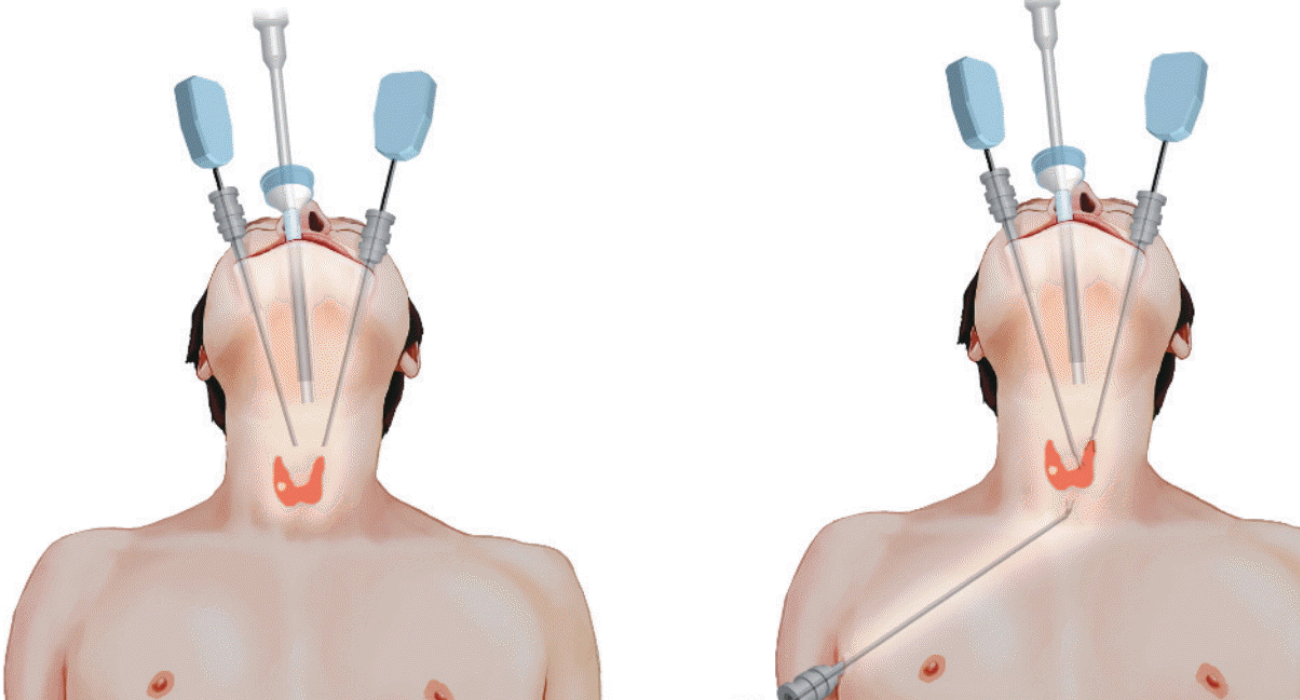Thyroid cancer is a prevalent form of cancer that affects the endocrine system, and its incidence is increasing globally. The encouraging news is that it is often manageable, particularly when diagnosed early. A standard treatment for thyroid cancer is surgical removal of the thyroid gland, known as thyroidectomy. In recent years, robotic thyroid surgery has emerged as a state-of-the-art approach, offering numerous advantages compared to traditional open surgery. In this blog, we will explore the reasons why selecting robotic thyroid surgery for thyroid cancer can be a beneficial choice for both patients and surgeons.
1.Enhancing precision and accuracy
Robotic thyroid surgery, also referred to as robotic-assisted thyroidectomy, utilizes cutting-edge technology to deliver unmatched precision and accuracy during the procedure. This is accomplished by employing robotic arms under the expert guidance of a skilled surgeon, ensuring meticulous movements and enhanced visualization.
The robotic system effectively mitigates the risk of inadvertent harm to adjacent structures, including nerves and blood vessels, thereby minimizing the likelihood of complications. This advanced technology ensures precision and safety, enhancing patient outcomes and overall surgical success.
2. Minimally invasive approach
One of the primary reasons why robotic thyroid surgery is gaining popularity among both patients and surgeons is its minimally invasive nature. Traditional open surgery requires a large incision in the neck, whereas robotic thyroid surgery only requires small keyhole incisions, reducing scarring and potential postoperative discomfort for patients. The smaller incisions lead to a quicker recovery time, allowing patients to resume their daily activities sooner. Additionally, the minimally invasive approach reduces the risk of infection and other postoperative complications.
3. Improved visualization and ergonomics
The use of robotic technology provides surgeons with an unparalleled view of the surgical area due to the high-definition 3D camera system. This allows for improved visualization of delicate structures, such as the thyroid gland and surrounding nerves and blood vessels. This enhanced view enables surgeons to perform precise movements with the robotic arms, leading to a more accurate surgery. Furthermore, the ergonomic design of the robotic system allows for better maneuverability and dexterity, reducing surgeon fatigue during longer procedures.
4. Greater patient satisfaction
Robotic thyroid surgery has been shown to result in greater patient satisfaction compared to traditional open surgery. This is due to the smaller incisions, reduced scarring, and quicker recovery time, leading to less post-operative pain and discomfort. Patients also report a higher level of confidence in the surgical outcome when undergoing robotic thyroid surgery.
5. Widening access to care
With advancements in technology and the increasing availability of robotic systems, more hospitals and surgical centers are able to offer robotic thyroid surgery. This provides patients with a wider range of options for their treatment, allowing them to seek out specialized surgeons who have experience in robotic thyroid surgery.
Furthermore, robotic surgery can be performed on an outpatient basis, meaning patients do not need to stay overnight in the hospital, reducing the overall cost of care and increasing convenience for patients.
6. Future possibilities
The use of robotic technology in thyroid surgery is still a relatively new concept, and there are ongoing research efforts to further improve its capabilities. With the potential for more precise movements, reduced surgical times, and even remote surgeries where the surgeon operates from a different location, the future of robotic thyroid surgery is promising.
Additionally, the use of artificial intelligence and machine learning algorithms could potentially aid in pre-operative planning and decision-making for complex cases.
7.Improved Cosmetic Outcome
A potential benefit of robotic thyroid surgery is the improved cosmetic outcome. This is especially important for patients who are concerned about visible scarring on their neck from traditional open surgery. With smaller incisions and less tissue disruption, robotic surgery can result in minimal scarring or even hidden scars, leading to increased patient satisfaction and confidence in their appearance post-surgery.
8.Better Access to Challenging Areas
Situated in a delicate area of the neck, nestled amidst vital structures like the parathyroid glands and recurrent laryngeal nerves, lies the thyroid gland. Robotic thyroid surgery offers surgeons enhanced precision and ease when navigating these intricate regions. The advanced visualization and maneuverability of the robotic system enable safer navigation through intricate anatomical structures, significantly reducing the likelihood of complications.
9.Experienced Surgeon Control
It's important to note that while robotic-assisted thyroidectomy offers advanced technology, the surgeon remains in full control throughout the procedure. The robotic system acts as an extension of the surgeon's hands, allowing for precise movements and enhanced visualization. Surgeons who perform robotic thyroid surgery undergo specialized training to ensure safe and effective use of the technology.
10.Potential for Quicker Return to Normal Diet
Traditional open thyroid surgery may require dietary restrictions for a longer period due to the potential for difficulty swallowing and discomfort. Robotic thyroid surgery can minimize such issues, allowing patients to return to a normal diet more quickly. This is not only more convenient but also aids in the patient's overall recovery and well-being.
Conclusion
Robotic thyroid surgery represents a remarkable breakthrough in the realm of thyroid cancer treatment. This cutting-edge technique brings forth a multitude of advantages for patients, encompassing unparalleled precision, minimal scarring, expedited recovery periods, diminished pain and discomfort, enhanced cosmetic results, and a lowered risk of complications. Surgeons also appreciate the enhanced capabilities of the robotic system, which allows for better access to challenging areas and a customized approach for each patient.
With the ever-evolving technology, the future of robotic thyroid surgery holds immense promise, offering enhanced precision and better outcomes. For those dealing with thyroid cancer, considering the possibility of robotic-assisted thyroidectomy, performed by a skilled surgeon, can lead to a safer, more comfortable, and aesthetically pleasing treatment journey. Ultimately, the choice to undergo robotic thyroid surgery should be made after consulting with a healthcare professional, considering the individual's specific circumstances and personal preferences. It is important to carefully evaluate all factors before making a decision.

